The ADATA Ultimate SU750 1TB SSD Review: Realtek Does Storage, Part 1
by Billy Tallis on December 6, 2019 8:00 AM ESTAnandTech Storage Bench - Heavy
Our Heavy storage benchmark is proportionally more write-heavy than The Destroyer, but much shorter overall. The total writes in the Heavy test aren't enough to fill the drive, so performance never drops down to steady state. This test is far more representative of a power user's day to day usage, and is heavily influenced by the drive's peak performance. The Heavy workload test details can be found here. This test is run twice, once on a freshly erased drive and once after filling the drive with sequential writes.
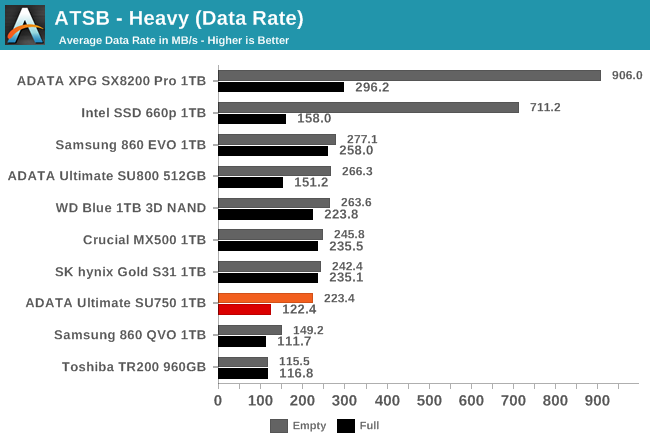
The empty-drive performance of the ADATA Ultimate SU750 on the Heavy test approaches that of the mainstream SATA SSDs, but when the test is run on a full drive its performance drops down to be on par with the other entry-level drives: the Toshiba TR200 DRAMless TLC SSD, and the Samsung 860 QVO with QLC NAND.
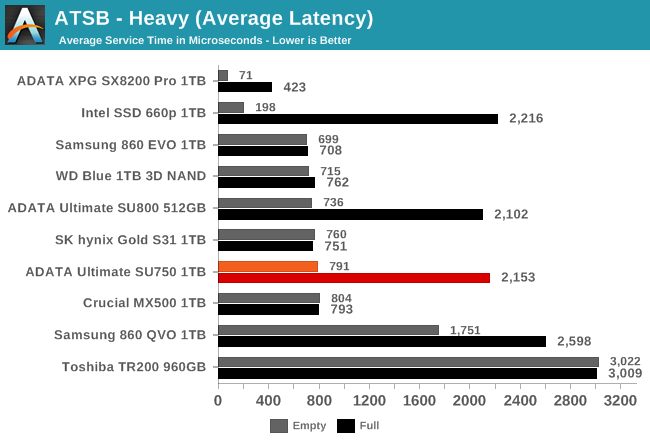
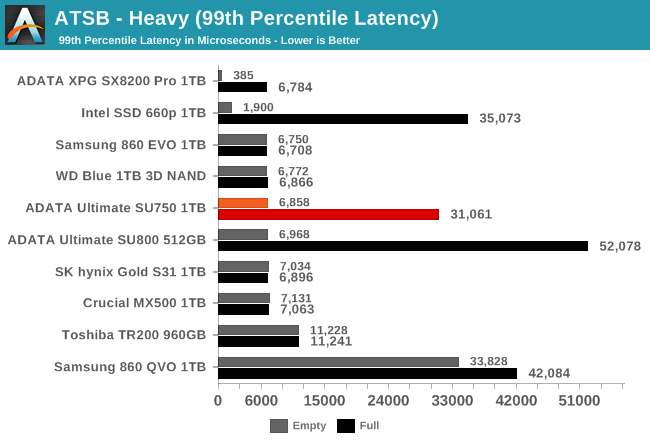
The average and 99th percentile latency scores repeat the same story: the SU750 handles the Heavy test well when run on an empty drive, but when full it struggles like other entry-level drives.
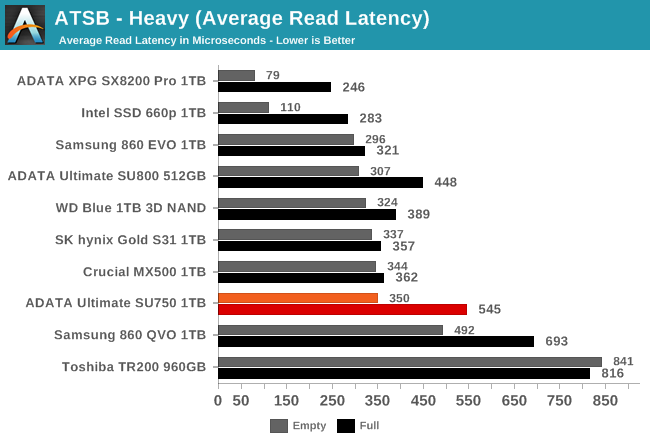
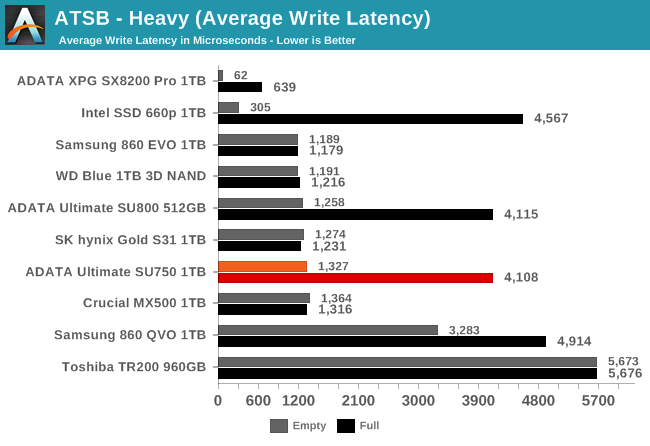
The average write latency for the SU750 on the Heavy test shows a much larger full-drive performance penalty than the average read latency scores, but in either case it comes out well ahead of the other two entry-level SATA drives.
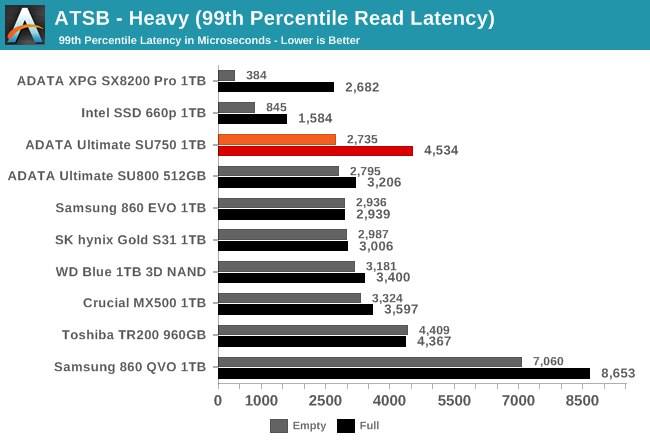
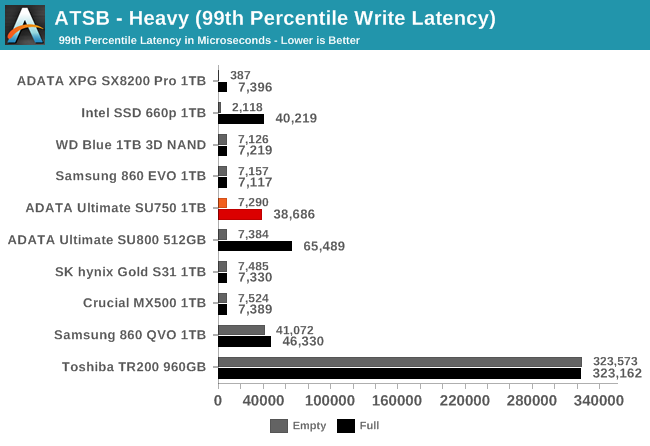
The 99th percentile read and write latencies from the SU750 are both competitive with mainstream SATA drives when the test is run on a full drive. When full, the 99th percentile read latency on the SU750 takes a hit that makes it slightly slower than the Toshiba TR200. For writes, the SU750's QoS is hurt quite a bit more, but the TR200 shows just how bad things could have been.
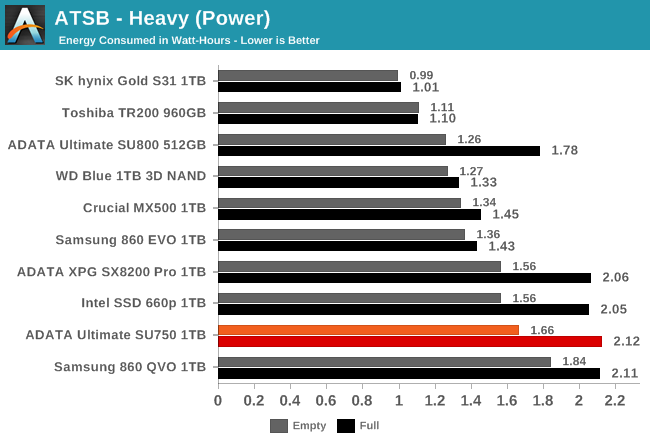
Power consumption is again pretty high for the SU750, especially for the full-drive test run. The two NVMe drives somewhat obscure the big gap that separates the SU750 and 860 QVO from the rest of the SATA SSDs.










54 Comments
View All Comments
sonny73n - Friday, December 6, 2019 - link
Realtek does audioRealtek does networking
Realtek does storage
Debbie does Dallas
RadiclDreamer - Friday, December 6, 2019 - link
Realtek may do all of these things, but it does them all poorly.FunBunny2 - Friday, December 6, 2019 - link
"Realtek may do all of these things, but it does them all poorly."Debbie wasn't so hot either. :):)
boozed - Friday, December 6, 2019 - link
I don't know that I'd call them poor. Good value, reliable (in my experience) and good enough for the vast majority of users.Other options are available for enthusiasts.
eek2121 - Friday, December 6, 2019 - link
The trouble is that you are talking about a few dollars for a much faster and more power efficient drive. This controller appears DOA as it brings nothing unique to the table.Samus - Saturday, December 7, 2019 - link
With what Intel charges for network controllers, it’s astonishing Realtek is in business when you consider how superior an Intel NIC is while being a few dollars more. And wireless is a whole different story. I’d put Realtek at the absolute bottom of the list. Atheros/Qualcomm, Intel, Agere, Lucent, Broadcom, all have better reliability, support (which is shocking when you consider how vastly used Realtek products are) and generally - performance, than competing Realtek solutions.I think where Realtek scores is availability. Their volume shows commitment to OEM’s that require dependable shipping schedules. This can be as important is BOM pricing, and when you look at the numbers, it seems (and I’m speculating) Realtek designs products for volume production more than anything else. The incredibly low pin count and a 2 channel controller back this up. We are talking about possibly the most basic SATA SSD controller in production and that means they will be able to make a shitload of them really fast really cheap.
And unfortunately OEMs will bite because they know 90% of the people buying this crap don’t care about the inner margin performance of an SSD. Most people buy on price, reliability and warranty.
This shitty SSD May have all 3 bases covered considering the quality binning of Micron NAND.
close - Saturday, December 7, 2019 - link
"a few dollars more" adds up when buying by the truckload. With millions of devices that have a network chipset that's quite some money.jabber - Sunday, December 8, 2019 - link
Yeah amazing how many people don't realise how shaving just 50 cents off a product that will sell hundreds of thousands to millions will save a company a fortune and help with profit.A good example is to watch the documentary "Building a Faster Horse" on how Ford designed and built the 2016 iirc Ford Mustang. Every single part and component was scrutinised to see if it could be either removed/simplified or made cheaper.
That's why Realtek exists still. Their parts are 50c cheaper than Intels.
Manch - Monday, December 9, 2019 - link
Ford been making the Mustang cheaper and cheaper while charging more and more. Started with the Getrag MT-82 grenade and got worse with the crap IRS, corner cutting everywhere. Add on top of it a horrid design (Looks like a 2 door Focus) and they wonder why they're losing customers.hanselltc - Saturday, December 7, 2019 - link
Killer